Acer Mounts A Stiff Innovation And Value Challenge To Apple In The Laptop Space
Wednesday, April 15, 2009
by Charles W. Moore
Apple is pretty much acknowledged as the innovation leader in computer design, even by Apple non-fans. The unibody MacBooks are a topical case in point. Nobody else has anything quite like their solid, one-piece housing carved from a single billet of aluminum.
However, I have to say that world number three computer maker (number two in laptops) Acer is coming out with some mighty attractive and clever notebooks these days, in some aspects raising the bar past Apple’s Current state of the art.
I’ve long been of a mind that were I to stray from Apple’s fold, it would likely be into Acer’s Garden of notebook delights. I’ve been a vicarious admirer of Acer’s Ferrari-themed notebooks for years —- very enticing pieces of work for a lifelong car freak and Formula One fan — and when a friend who I knew I had zero chance of convincing to buy a Mac asked my advice on what to get to replace her ancient PC, I suggested a modestly priced but nicely equipped Acer laptop, which has now served her well for several years — albeit “well” in the Windows sense.
Which is of course the proverbial fly in the ointment when it comes to my admiration of Acer hardware. It won’t run on OS X, or at least not above the board under the terms of Apple’s EULA. Linux is an increasingly attractive alternative to Windows, but although I’ve had glowing reports from readers using Ubuntu on netbooks, it’s not really a satisfactory substitute for OS X.
My IT professional daughter, who is a Mac OS veteran and fan but has spent most of her working career on PCs, including a stint as a Windows XP telephone tech support agent, runs a Macintosh install of Leopard on a Dell desktop PC, with audio in/out working through a Griffin iMic USB sound adapter and video out functioning as well, thinks it’s silly to pony up hundreds of dollars more for a Mac system than what you pay for a PC with similar power and equipment specs, but I prefer to keep things kosher, and I’m not really interested in messing around with the tedium of hacked OS installs.
However, a new fleet of Acer notebooks announced at a press conference in New York last week might have had me wavering, had I not just invested in a new unibody MacBook 2 months ago. I hasten to add that I just love the MacBook, so am not seriously thinking of defection anytime soon, but that doesn’t mean I can’t be favorably impressed with Acer’s latest offerings, some of which are quite delectable, and which, as I said, have in some respects raised the bar several notches past the mark established by Apple with the unibodies.
Apparently no flies on Acer in the quality department either. In RESCUECOM’s Computer Reliability Report released last month based on a sample of 15,000+ calls throughout the quarter measuring the quality of components and software used in manufacturing the computer and after-the-sale support the manufacturer provides to its customers, Acer finished ahead of Apple, although some have questioned the verity of that survey. Acer Group is now the number three computer maker in sales behind Dell and HP, and number two in notebooks, albeit a substantial chunk of their portable sales are accounted for by moving 5 million hot-selling but low-profit netbooks, and in http://www.chron.com/disp/story.mpl/tech/news/6372484.html an interview this week with Bloomberg news, Acer chairman J.T. Wang said that the company’s goal and anticipation is to become the world’s number-one notebook vendor.
Speaking of which, it was inevitable that the distinction between netbooks and notebooks would become blurred over time, and the new Aspire One 11.6” screen notebook Acer unveiled last week is the most paradigmatic manifestation of that to date.
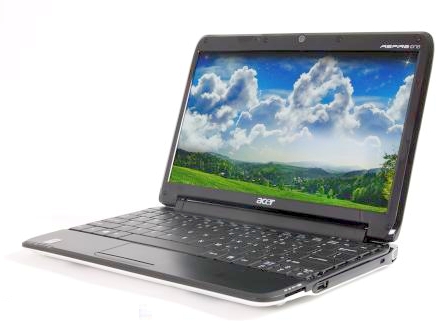
The one inch (2.5 cm) thick 11.6” Aspire One is still powered by an ultra low power consumption Intel Atom processor (of unspecified clock speed as yet but possibly the new Z-series Atom announced last week by Intel — the 1.33-GHz Atom Z520, the 1.6-GHz Z530 or perhaps even the new 2GHz Z550) with graphics supported by a Mobile Intel US15W Express Chipset, but comes with a 160 GB internal hard drive and a full sized ‘soft-touch’ keyboard.
Also included with the “big” Aspire One will be a a five-in-one card reader, WiFi 802.11b/g, Bluetooth, and 3G connectivity, Dolby Pro Logic sound and a WXGA 1,366 x 768 resolution LED back-lit screen. The machine weighs in at just a little more than one kilo (about two and a half pounds) and Acer claims 8 hours battery runtime on the 6 cell 5200 mAh battery, made possible by Intel technologies2 and Intel Display Power Savings Technology that reduces backlighting with minimal visual impact. You tap the Acer PowerSmart key to engage these and other advanced settings to shift the notebook into power saving mode that Acer claims is up to 40% more efficient than a typical laptop.
There is a digital microphone and Acer Crystal Eye a webcam built into the display frame and a ‘multi-gesture’ touchpad, three USB ports, and VGA-out.
It will be a cool runner too, because the ULV Atom chips generate less hear to start with, while Intel’s Laminar Wall Jet technology uses louvered inlets to quietly jet cool air across the notebook’s bottom.
The bigger display (not much smaller than the ones in the erstwhile 12” Apple PowerBook and iBooks) along with the standard sized keyboard and decent 160 GB hard drive capacity (40 GB better than Apple gives you in the entry-level white MacBook) address three of the netbook’s deficiencies, and If Acer can keep the price (as yet unannounced) in the $500 - $700 neighborhood, they should sell boatloads of these.
However, the 11.6” Aspire One was just one element of Acer’s new small and light ADC laptop innovation push.
There’s also the slightly larger and unequivocally notebook new Aspire Timeline series which has been specifically designed to provide longer battery life not by using a bulkier and heavier battery but by redesigning the way power is used, making the system more efficient to provide more than eight hours of battery life on a single charge.
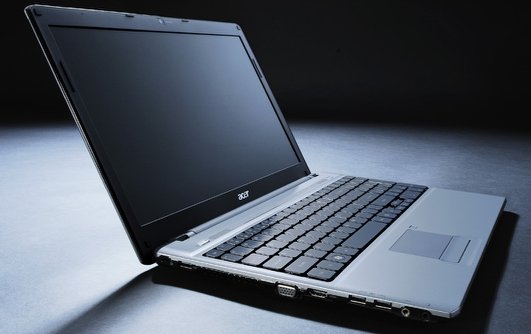
The Aspire Timeline notebooks come with the Acer Smart Power key that gives you more control over how long the battery will last: just press the Smart Power key to boost power saving capabilities and extend battery life through advanced settings and a series of actions to reduce power consumption.
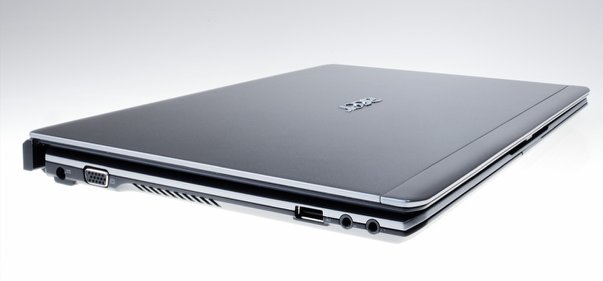
The Acer Aspire Timeline is 24mm (less than one inch), rising just 5 mm at its highest, weighing from 1.6kg (3.5lb) for the 13.3” model up to 2.4kg (5.3lb) for the 15.6” version, and incorporating the Laminar Wall Jet cooling technology developed in collaboration with Intel referenced in the Aspire One profile above.
With their Acer Power Smart adapter, the Aspire Timeline notebooks are claimed to consume up 66% less juice than required by Energy Star -- equivalent to 1,752 watt per year or what a 15 watt bulb lit for 116 days would consume. The Power Smart adapter enters adaptive charging mode automatically when the battery is fully charged, which stops it consuming energy and reduces the tear and wear on the battery.
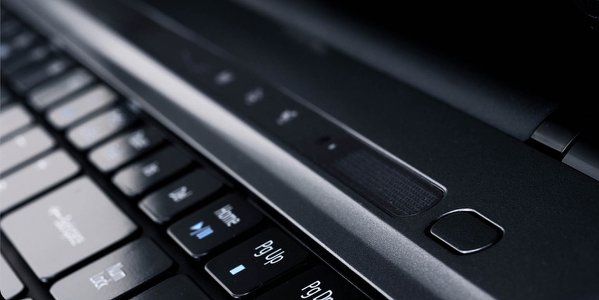
The Timeline’s glossy “FineTip” keyboard has comfortably sized and spaced keys, while the touchpad includes a lock to avoid mis-touch when typing and touchpad button with a step design to find it easily even without looking. This multi-gesture touchpad allows you to use circular clockwise or counterclockwise finger motion to navigate web pages, lists of files, music playlists or photos; you can pinch to zoom-in or zoom-out with various applications; and browse photos, web pages, PDF documents or media albums by sliding two fingers horizontally.
Acer’s Aspire Timeline series is available in three screen sizes: featuring 13.3”, 14” and 15.6 Acer CineCrystal LED backlit displays with 16:9 aspect ratio, 1366 x 768 HD resolution, and are equipped with Dolby Sound Room technology that offers a surround sound effect from any pair of speakers or headphones.
The Aspire Timeline Series includes built-in Wi-Fi/WiMAX functionality supporting Acer SignalUp, and can be specified with a choice of embedded 3G modules as an option. They have a Crystal Eye webcam, optimized for low light conditions and supporting enhanced Acer’s PrimaLite technology,
Processors are Intel Core 2 Duo Ultra Low Voltage variants, you choice of shared or dedicated VGA and hard drive options up to 500 GB of capacity, or an SSD with up to 64 GB of capacity.
The Acer Timeline series is expected to range in price from USD$699 to $899
Also announced last week was Acer’s stylish Aspire 3935 ultra-portable in 13.3-inch format in a distinctive golden-brown livery, Acer’s FineTip keyboard, with larger key caps and key spacing keys with a pearl gloss finish floating on the shiny base and a multi-gesture touchpad.
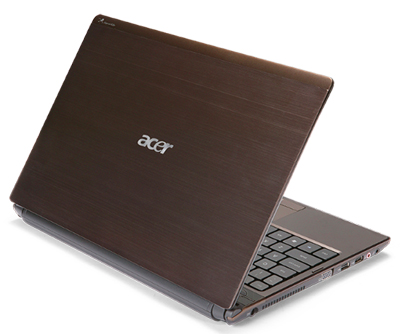
The Aspire 3935 should also prove tough with it’s metal chassis with a brushed-metal housing finish, equipped with Wi-Fi/WiMAX and optional 3G wireless, an integrated Acer Crystal Eye webcam supporting enhanced Acer PrimaLite technology, an LED backlit 13.3” HD 1366 x 768 resolution Acer CineCrystal LCD with 16:9 aspect ratio, Dolby-optimized surround sound system with two built-in stereo speakers and 3rd Generation Dolby Home Theater audio enhancement, the Acer SmartPower button power saving switch that gives you control over battery life, and with the optional 8-cell battery can give you up to 8 hours of runtime.
The Aspire 3935 is powered by an Intel Centrino 2 Core 2 Duo processor and Mobile Intel GM45 Express chipset with integrated 3D graphics, up to 4 GB of DDR3 1066 MHz memory and several hard disk or SSD options, and optional Acer Bio-Protection fingerprint recognition.
With offerings like these it’s easy to understand why Acer is doing so well in the laptop space these days, and while I’m still convinced Apple has the edge in design elegance (not to mention the OS X advantage), it is lagging PC competitors in price, standard hard-drive capacity, standard and maximum RAM support, connectivity and expansion flexibility, and tends to be middle-of-the pack in graphics power, processor speed, and other performance determinants. Mr. WAg told Bloomberg that Acer expects to sell Acer will sell 12 to 15 million Aspire One netbooks and 7 to 10 million Timeline laptops in 2009.
Like I said, I’m very happy with my decision to go with the unibody MacBook, but I think many users will also be delighted with these new Acer Aspires so long as they can tolerate working with Windows or Linux, and I keep hearing that Windows 7 will be stiffer competition for OS X.
For more information, visit:
http://www.acer.com/
Note: Letters to PowerBook Mystique Mailbag may or may not be published at the editor's discretion. Correspondents' email addresses will NOT be published unless the correspondent specifically requests publication. Letters may be edited for length and/or context.
Opinions expressed in postings to PowerBook Mystique MailBag are owned by the respective correspondents and not necessarily shared or endorsed by the Editor and/or PowerBook Central management.
If you would prefer that your message not appear in PowerBook Mystique Mailbag, we would still like to hear from you. Just clearly mark your message "NOT FOR PUBLICATION," and it will not be published.
CM